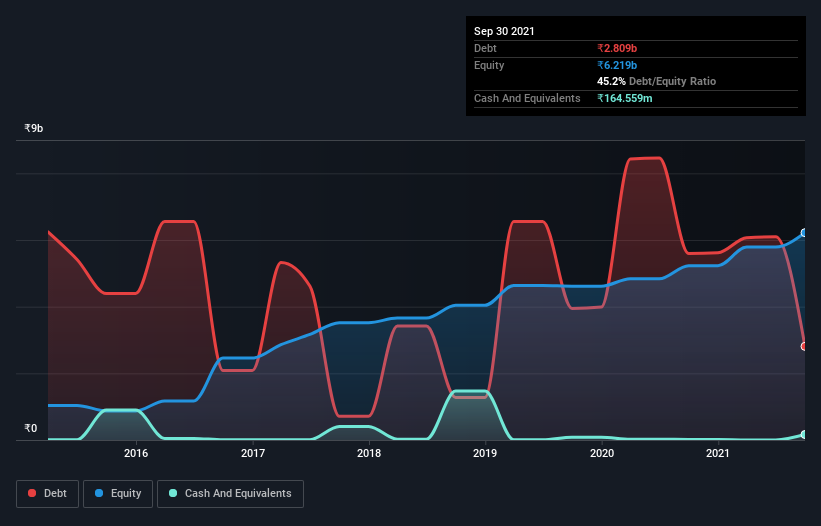Does Dwarikesh Sugar Industries (NSE:DWARKESH) Have A Healthy Balance Sheet?
Some say volatility, rather than debt, is the best way to think about risk as an investor, but Warren Buffett famously said that 'Volatility is far from synonymous with risk.' So it seems the smart money knows that debt - which is usually involved in bankruptcies - is a very important factor, when you assess how risky a company is. As with many other companies Dwarikesh Sugar Industries Limited (NSE:DWARKESH) makes use of debt. But the more important question is: how much risk is that debt creating?
Why Does Debt Bring Risk?
Debt and other liabilities become risky for a business when it cannot easily fulfill those obligations, either with free cash flow or by raising capital at an attractive price. In the worst case scenario, a company can go bankrupt if it cannot pay its creditors. While that is not too common, we often do see indebted companies permanently diluting shareholders because lenders force them to raise capital at a distressed price. Of course, plenty of companies use debt to fund growth, without any negative consequences. The first thing to do when considering how much debt a business uses is to look at its cash and debt together.
View our latest analysis for Dwarikesh Sugar Industries
What Is Dwarikesh Sugar Industries's Net Debt?
As you can see below, Dwarikesh Sugar Industries had ₹2.81b of debt at September 2021, down from ₹5.59b a year prior. On the flip side, it has ₹164.6m in cash leading to net debt of about ₹2.64b.

A Look At Dwarikesh Sugar Industries' Liabilities
We can see from the most recent balance sheet that Dwarikesh Sugar Industries had liabilities of ₹2.13b falling due within a year, and liabilities of ₹1.46b due beyond that. Offsetting these obligations, it had cash of ₹164.6m as well as receivables valued at ₹324.1m due within 12 months. So it has liabilities totalling ₹3.10b more than its cash and near-term receivables, combined.
Since publicly traded Dwarikesh Sugar Industries shares are worth a total of ₹16.5b, it seems unlikely that this level of liabilities would be a major threat. Having said that, it's clear that we should continue to monitor its balance sheet, lest it change for the worse.
We use two main ratios to inform us about debt levels relative to earnings. The first is net debt divided by earnings before interest, tax, depreciation, and amortization (EBITDA), while the second is how many times its earnings before interest and tax (EBIT) covers its interest expense (or its interest cover, for short). Thus we consider debt relative to earnings both with and without depreciation and amortization expenses.
While Dwarikesh Sugar Industries's low debt to EBITDA ratio of 1.1 suggests only modest use of debt, the fact that EBIT only covered the interest expense by 5.7 times last year does give us pause. So we'd recommend keeping a close eye on the impact financing costs are having on the business. Importantly, Dwarikesh Sugar Industries grew its EBIT by 45% over the last twelve months, and that growth will make it easier to handle its debt. The balance sheet is clearly the area to focus on when you are analysing debt. But it is Dwarikesh Sugar Industries's earnings that will influence how the balance sheet holds up in the future. So when considering debt, it's definitely worth looking at the earnings trend. Click here for an interactive snapshot.
Finally, a company can only pay off debt with cold hard cash, not accounting profits. So we clearly need to look at whether that EBIT is leading to corresponding free cash flow. In the last three years, Dwarikesh Sugar Industries's free cash flow amounted to 49% of its EBIT, less than we'd expect. That weak cash conversion makes it more difficult to handle indebtedness.
Our View
Happily, Dwarikesh Sugar Industries's impressive EBIT growth rate implies it has the upper hand on its debt. And its net debt to EBITDA is good too. When we consider the range of factors above, it looks like Dwarikesh Sugar Industries is pretty sensible with its use of debt. That means they are taking on a bit more risk, in the hope of boosting shareholder returns. The balance sheet is clearly the area to focus on when you are analysing debt. But ultimately, every company can contain risks that exist outside of the balance sheet. To that end, you should learn about the 4 warning signs we've spotted with Dwarikesh Sugar Industries (including 1 which is a bit concerning) .
If, after all that, you're more interested in a fast growing company with a rock-solid balance sheet, then check out our list of net cash growth stocks without delay.
New: Manage All Your Stock Portfolios in One Place
We've created the ultimate portfolio companion for stock investors, and it's free.
• Connect an unlimited number of Portfolios and see your total in one currency
• Be alerted to new Warning Signs or Risks via email or mobile
• Track the Fair Value of your stocks
Have feedback on this article? Concerned about the content? Get in touch with us directly. Alternatively, email editorial-team (at) simplywallst.com.
This article by Simply Wall St is general in nature. We provide commentary based on historical data and analyst forecasts only using an unbiased methodology and our articles are not intended to be financial advice. It does not constitute a recommendation to buy or sell any stock, and does not take account of your objectives, or your financial situation. We aim to bring you long-term focused analysis driven by fundamental data. Note that our analysis may not factor in the latest price-sensitive company announcements or qualitative material. Simply Wall St has no position in any stocks mentioned.
About NSEI:DWARKESH
Dwarikesh Sugar Industries
Engages in the manufacture and sale of sugar and ethanol in India and internationally.
Flawless balance sheet with reasonable growth potential.
Market Insights
Community Narratives




